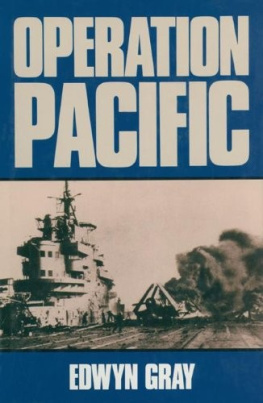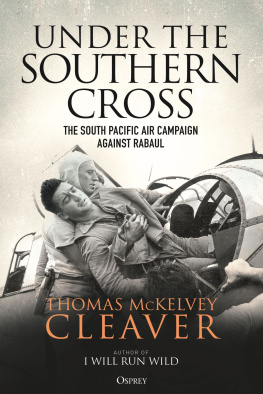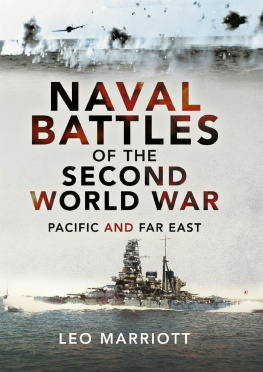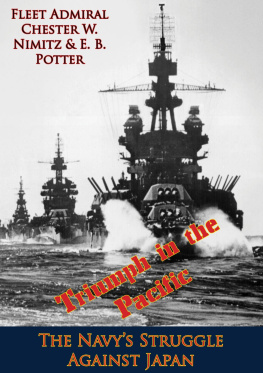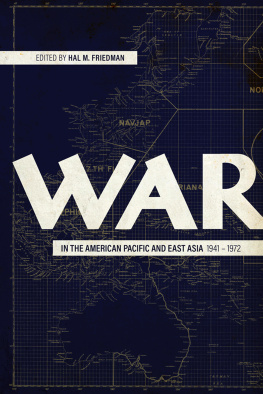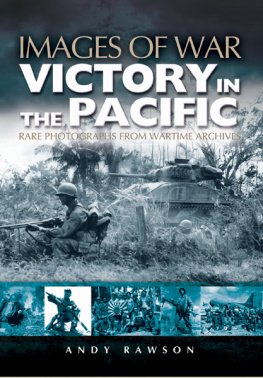Operation Pacific
* * *
by the same author
Non Fiction
A Damned Un-English Weapon
The Killing Time
The Devils Device
Few Survived
Captains of War
Fiction
No Survivors
Action Atlantic
Tokyo Torpedo
Last Command
Fighting Submarine
Devil Flotilla
Diving Stations
Crash Dive 500
OPERATION PACIFIC
The Royal Navys
War against Japan
19411945
EDWYN GRAY
First published in 1990
Leo Cooper is an imprint of the
Octopus Publishing Group, Michelin House,
81 Fulham Road, London SW3 6RB
LONDON MELBOURNE TORONTO
Copyright Edwyn Gray, 1990
A CIP catalogue record for this book
is available from the British Library.
ISBN 0 85052 264 1
Typeset in 11/13pt Linotron Sabon
by Hewer Text Composition Services, Edinburgh
Printed in England by
Clays Ltd, St Ives plc
Contents
* * *
For Vivienne, with love
Illustrations
* * *
All photographs reproduced by courtesy of The Imperial War Museum.
Due to a strange quirk in the British character which prefers to dwell on failure rather than success much more has been written about the sinking of the Prince of Wales and Repulse and the Royal Navys early run of defeats in the Far East than about the British Pacific Fleets attacks on Palembang and Sakishima Gunto, the destruction of the Japanese cruiser Haguro, and of Britains not inconsiderable naval contribution to ultimate victory in the Pacific.
However, although a large amount of first-class material is available about the tragic disasters that befell the Royal Navy in 1941 and 1942, most books dealing with the period are limited either to specific aspects of the battle to save South-East Asia from Japanese aggression or to an examination of particular episodes such as the sinking of Force Z in meticulous detail. With two notable exceptions in which the late Captain Donald Macintyre dismisses the British Pacific Fleet in a single sentence, omits mention altogether of its C-in-C, Admiral Sir Bruce Fraser, and totally ignores the landings and inshore operations that led to Britains victory in Burma.
Many other writers tend to sub-divide the complex and far-flung operations of 1945 into neatly independent compartments in which the work of the British Pacific Fleet, the East Indies Fleet, the Arakan Inshore flotillas, and the Royal Navys submarines, are each handled separately and, in the minority of cases, without reference one to another. In so doing they say virtually nothing about the ships of the Commonwealth navies and the vital tasks they performed at every stage of the Pacific campaign while the interregnum period during which Britains Eastern Fleet was forced to lurk in East African waters for upwards of two years is either not mentioned or is compressed into a few vague paragraphs. The result, while commendably simplifying a very complicated pattern of events, has the unintentional effect of presenting a misleading picture which fails to reflect adequately the simultaneity of the Royal Navys operations in the various and widely separated theatres of combat in the Far East.
For example between 11 and 14 April, 1945, the British Pacific Fleet, taking position on the left flank of the US 5th Fleet during the assault on Okinawa, was launching massive air strikes on Japanese bases in the islands of Sakishima Gunto while, at the same time, fighting off kamikaze attacks; Force 62 of the East Indies Fleet was engaged in an anti-shipping sweep along the Burma coast; Force 63, also drawn from the East Indies Fleet, was carrying out shore bombardments and repelling Japanese bombers off Sumatra; units of the Arakan Inshore Flotilla were sinking enemy river-craft in the area of Ramree Island during operations in support of the 14th Army; and, as part of the routine submarine war, the Stygian sank a Japanese minesweeper in the Java Sea. In addition to these activities the Navys midget submarine flotilla had just arrived in Pearl Harbor en route for Australia and its subsequent attacks against enemy warships at Singapore; Americas Admiral Ernest King was busy trying to divert British naval strength into a series of side-show landings in Borneo in an anglophobic attempt to prevent the Royal Navy from operating alongside the US 3rd Fleet in Japanese home waters; and, finally, Britains hastily assembled and inadequate Fleet Train of oilers and store ships were struggling to keep the fleet replenished at sea off Formosa while waterfront labour disputes in Australia were causing chaos in our rear supply areas.
Such was the extent of the Royal Navys work in the Far East in a period of just four days in 1945. And, remember, at this particular time the war against Hitler was not yet over and British ships were still engaged in European waters and on escort duties in the Atlantic!
The purpose of this book, therefore, is to provide the reader with a comprehensive account of the Royal Navys battle with Japan from the first assault on the Shanghai Concession and landings in Malaya in December, 1941, to the signing of the Instrument of Surrender in Tokyo Bay in September, 1945, when a British Admiral, Sir Bruce Fraser, penned his signature alongside, and equally with, those of General Douglas MacArthur and Admiral Chester Nimitz. It is for the most part a sombre narrative of tragedy and defeat. But it concludes with the final march to victory and it contains many moments of glory, self-sacrifice and heroism. It is certainly a story worth the telling.
In dealing with the later stages of the Pacific conflict I have been somewhat critical of the stance taken by various American admirals and generals whose blinkered anglophobic outlook on British participation in the final defeat of Japan caused much lasting ill-feeling and which was, no doubt, politically inspired. May I take this opportunity to say that these criticisms in no way reflect upon the superb fighting quality of the United States Navy, its excellent ships and men, and its incredibly efficient organization. And it remains a continuing matter of regret to me that the British public at large has never fully appreciated the valour and sacrifice of American soldiers, sailors, airmen and marines in both Europe and the Far East the latter often fighting in terrible conditions against a fanatical enemy who frequently and literally fought to the last man and the last bullet.
The material which forms the basis of this book has been accumulated over many years of writing on naval matters and has been derived from contemporary documents, newspapers, books and conversations and correspondence with very many people each and all of whom receive my grateful appreciation. I must also acknowledge my debt to the various publishers and authors who have kindly consented to my use of copyright material: Michael Joseph Ltd, William Heinemann Ltd, Cassell & Co Ltd, Allen Lane (Viking), Her Majestys Stationery Office, Unwin Hyman Ltd, William Kimber Ltd, George G. Harrap & Co Ltd, William Collins Sons & Co Ltd, Whittlesey House, Cassell Australia, Weidenfeld & Nicolson Ltd, Ian Allen Ltd, Routledge Kegan Paul, Sidgwick & Jackson Ltd, Eyre & Spottiswood Ltd, and Frederick Muller. I am indebted to the US Navy and the National Archives in Washington for the photographs.
My thanks too to Leo Cooper and Nat Sobel for their support and encouragement and to Vivienne for continuing to cope with the boredom of being an authors wife.
Two final points: firstly, while I have tried to indicate Commonwealth ships in the text this has not always been possible and references to the Royal or British Navy should be construed to include Commonwealth forces and, secondly, so far as I have been able and unless otherwise indicated, all times used in the narrative are local.
Next page
